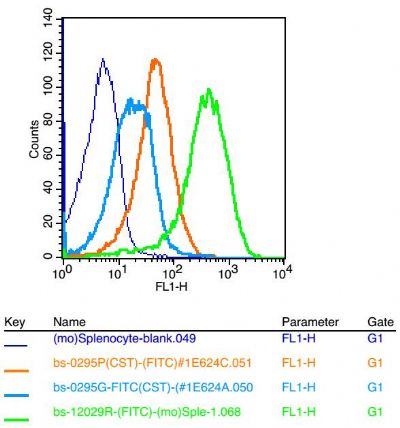GPRC5B Polyclonal Antibody
Purified Rabbit Polyclonal Antibody (Pab)
- 产品详情
- 实验流程
Application
| IHC-P, IHC-F, IF, ICC, E |
|---|---|
| Primary Accession | Q9NZH0 |
| Reactivity | Rat, Pig, Dog, Bovine |
| Host | Rabbit |
| Clonality | Polyclonal |
| Calculated MW | 44795 Da |
| Physical State | Liquid |
| Immunogen | KLH conjugated synthetic peptide derived from human G protein coupled receptor family C group 1 member B |
| Epitope Specificity | 1-100/403 |
| Isotype | IgG |
| Purity | affinity purified by Protein A |
| Buffer | 0.01M TBS (pH7.4) with 1% BSA, 0.02% Proclin300 and 50% Glycerol. |
| SUBCELLULAR LOCATION | Cell membrane. Cytoplasmic vesicle membrane. Localized in the plasma membrane and perinuclear vesicles. |
| SIMILARITY | Belongs to the G-protein coupled receptor 3 family. |
| Important Note | This product as supplied is intended for research use only, not for use in human, therapeutic or diagnostic applications. |
| Background Descriptions | GPRC5B (G protein-coupled receptor family C group 5 member B, retinoic acid-induced gene 2 protein) is a 403 amino acid protein encoded by the human GPRC5B gene. GPRC5B is an orphan receptor member of the G protein-coupled receptor 3 family. G protein-coupled receptors (GPCRs or GPRs) contain 7 transmembrane domains and transduce extracellular signals through heterotrimeric G proteins. Key roles for G protein-coupled receptors include control of protein maturation and cell surface delivery, and providing the correct framework for interactions with both heterotrimeric G proteins and arrestins to allow signal generation and termination. This retinoic acid-inducible G protein-coupled receptor provides evidence for a possible interaction between retinoid and G protein signaling pathways. GPRC5B is highly expressed in kidney, pancreas and testis, and has moderate expression in brain, heart, prostate, small intestine and spleen. |
| Gene ID | 51704 |
|---|---|
| Other Names | G-protein coupled receptor family C group 5 member B, A-69G12.1, Retinoic acid-induced gene 2 protein, RAIG-2, GPRC5B, RAIG2 |
| Target/Specificity | Expression is high in kidney, pancreas, and testis, medium in brain, heart, prostate, small intestine, and spleen, low in liver, placenta, skeletal muscle, colon, ovary, and thymus, and not detectable in lung and peripheral leukocyte. According to PubMed:10945465, highly expressed in most brain areas examined, with the highest levels observed in corpus callosum, caudate nucleus, putamen, substantia nigra, thalamus, hippocampus, and spinal chord as well as in dorsal root ganglia (DRG). In the periphery, expression levels are relatively low, compared to the CNS, with the strongest expression detected in pancreas, testis, uterus, and stomach. |
| Dilution | IHC-P=1:100-500,IHC-F=1:100-500,ICC=1:100-500,IF=1:100-500,Flow-Cyt=1 µg/Test,ELISA=1:5000-10000 |
| Storage | Store at -20 °C for one year. Avoid repeated freeze/thaw cycles. When reconstituted in sterile pH 7.4 0.01M PBS or diluent of antibody the antibody is stable for at least two weeks at 2-4 °C. |
| Name | GPRC5B |
|---|---|
| Synonyms | RAIG2 |
| Function | G-protein coupled receptor involved in the regulation of cell volume. |
| Cellular Location | Cell membrane; Multi-pass membrane protein. Cytoplasmic vesicle membrane; Multi-pass membrane protein. Note=Localized in the plasma membrane and perinuclear vesicles |
| Tissue Location | Expression is high in kidney, pancreas, and testis, medium in brain, heart, prostate, small intestine, and spleen, low in liver, placenta, skeletal muscle, colon, ovary, and thymus, and not detectable in lung and peripheral leukocyte. According to PubMed:10945465, highly expressed in most brain areas examined, with the highest levels observed in corpus callosum, caudate nucleus, putamen, substantia nigra, thalamus, hippocampus, and spinal cord as well as in dorsal root ganglia (DRG). Expressed in glia limitans, ependymal cells, astrocyte cell bodies, the perivascular region in astrocyte endfeet, but not in neurons (PubMed:37143309). In the periphery, expression levels are relatively low, compared to the CNS, with the strongest expression detected in pancreas, testis, uterus, and stomach. |
Research Areas
For Research Use Only. Not For Use In Diagnostic Procedures.
Application Protocols
Provided below are standard protocols that you may find useful for product applications.
终于等到您。ABCEPTA(百远生物)抗体产品。
点击下方“我要评价 ”按钮提交您的反馈信息,您的反馈和评价是我们最宝贵的财富之一,
我们将在1-3个工作日内处理您的反馈信息。
如有疑问,联系:0512-88856768 tech-china@abcepta.com.
¥ 1,500.00
Cat# AP54708























 癌症的基本特征包括细胞增殖、血管生成、迁移、凋亡逃避机制和细胞永生等。找到癌症发生过程中这些通路的关键标记物和对应的抗体用于检测至关重要。
癌症的基本特征包括细胞增殖、血管生成、迁移、凋亡逃避机制和细胞永生等。找到癌症发生过程中这些通路的关键标记物和对应的抗体用于检测至关重要。 为您推荐一个泛素化位点预测神器——泛素化分析工具,可以为您的蛋白的泛素化位点作出预测和评分。
为您推荐一个泛素化位点预测神器——泛素化分析工具,可以为您的蛋白的泛素化位点作出预测和评分。 细胞自噬受体图形绘图工具为你的蛋白的细胞受体结合位点作出预测和评分,识别结合到自噬通路中的蛋白是非常重要的,便于让我们理解自噬在正常生理、病理过程中的作用,如发育、细胞分化、神经退化性疾病、压力条件下、感染和癌症。
细胞自噬受体图形绘图工具为你的蛋白的细胞受体结合位点作出预测和评分,识别结合到自噬通路中的蛋白是非常重要的,便于让我们理解自噬在正常生理、病理过程中的作用,如发育、细胞分化、神经退化性疾病、压力条件下、感染和癌症。






